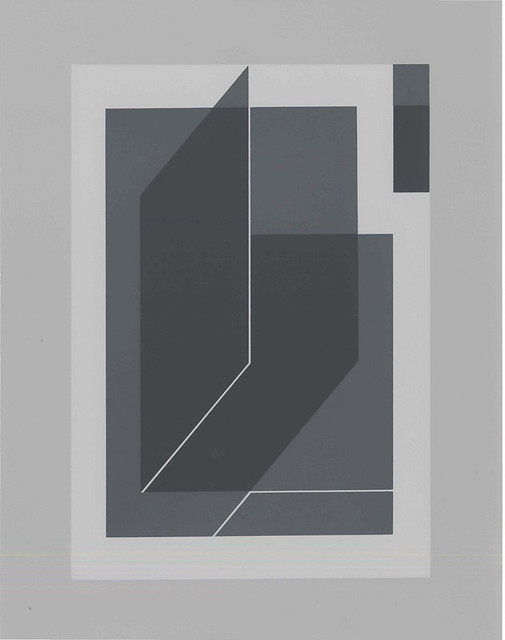This article is more than 5 years old.
If one says “Red” (the name of a color)
and there are 50 people listening,
it can be expected that there will be 50 reds in their minds.
And one can be sure that all these reds will be very different.Josef Albers, Interaction of Color (1963)
The artist Joseph Albers (1888-1976) was born in Germany and began his career as an art teacher, painter, and printmaker. In 1920 he enrolled in the new Bauhaus School in Weimar, where he studied under color theorist Johannes Itten and began to formulate his own theories about the perception and interaction of color. Albers eventually joined the Bahaus faculty and remained there until the Nazis closed the school in 1933. He and his wife, the artist Anni Fleischmann Albers, left Germany for Asheville, North Carolina when Black Mountain College offered Albers a teaching post. While at Black Mountain Albers became influential in the American art world as an artist, color theorist, and art teacher . He remained at the college until 1949, when he left to become head of the Design Department at Yale.
Color remained Albers’s main preoccupation in both his art and his teaching. He emphasized the changeable nature of color, demonstrating how color perception is affected by light, shape, motion, and juxtaposition of other colors. In 1963 he published Interaction of Color, in which he set forth his ideas about the teaching of color theory and provided plates, many of them interactive, for use in classroom settings.
Formulation : Articulation, a collection of 127 silkscreen prints of Albers’s works, was published in 1972. Albers himself selected the works and arranged their order.
The preface to Formulation : Articulation states that
The concept of this publication is the realization rather than the reproduction of the essential ideas in Josef Albers’ works. . . . No attempt has been made to present the work in chronological order; rather, for each portfolio the artist has placed the folders in a sequential order so that they may be seen and examined for their interaction. . . .
Albers collaborated with Yale colleagues Norman Ives and Sewell Sillman to design the book and produce the silkscreens, a process which took nearly two years. The finished product, published by Ives and Sillman in cooperation with Harry N. Abrams, consists of the plates and a booklet of notes by Albers, all contained in two large portfolio cases.
Below is a sampling of images from Formulation : Articulation, with Albers’s notes on each print or set of prints.
From oil of 1940, Bent Black. On tiptoe and pendant between points.
Repeated and not repeated.
II : 8
ON MY HOMAGE TO THE SQUARE
Seeing several of these paintings next to each other makes it obvious that each painting is an instrumentation of its own.
This means that they are all of different palettes, and therefore, so to speak, of different climates.
Choice of the colors used, as well as their order, is aimed at an interaction- influencing and changing each other forth and back.
Thus, character and feeling alter from painting to painting without any additional “hand writing,” or so-called texture.
Although the underlying symmetrical and quasi-concentric order of squares remains the same in all paintings — in proportion and placement — these same squares group or single themselves, connect and separate, in many different ways.
In consequence, they move forth and back, in and out, and grow up and down and near and far, enlarged and diminished. All this, to proclaim color autonomy as a means of a plastic organization.
II : 18
A rare palette for a Variant in six colors. See the color interaction, particularly the illusionary transparencies within the grays.
A quartet within an Homage to the Square which permits and deserves reversal — and, although reversed, the two remain twins.
Two original paintings by Albers– one of which is part of hisHomage to the Square series –are on view through December 31 at Reynolda House Museum of American Art as part of the special exhibit Modern Masters from the Smithsonian American Art Museum.
Z. Smith Reynolds Library’s copy of Formulation : Articulation is number 705 of 1000 copies printed. It was purchased by the Special Collections Department in 1986.
Select bibliography of works by and about Josef Albers in the ZSR Library collection:
Albers, Josef, and Francois Bucher. Despite Straight Lines. New Haven and London: Yale University Press, 1961.
Albers, Josef. Interaction of Color. New Haven: Yale University Press, 1963.
Albers, Josef., and Casa Luis Barragan. Homage to the Square: Josef Albers. Mexico, D.F.: Casa Luis Barragan, 2009.
Danilowitz, Brenda., Josef Albers, and Josef and Anni Albers Foundation. The Prints of Josef Albers: A Catalogue Raisonne, 1915-1976. New York : [Lanham, Md.?]: Hudson Hills Press in association with the Josef and Anni Albers Foundation, 2001.
Pakay, S., Weber, N. F., Albers, J., Albers, A., et. al. Hudson Film Works (Firm), & WMHT (Television station : Schenectady, N. (2006). Josef and Anni Albers: Art is everywhere. [Hudson, NY]: Hudson Film Works.











2 Comments on ‘Formulation : Articulation, by Josef Albers (1972)’
This is an excellent description of Josef Albers and his work!
Really interesting information on this artist. Thanks for making the connection between ZSR and Reynolda House. Makes me want to take a Rare Books/Reynolda House field trip!